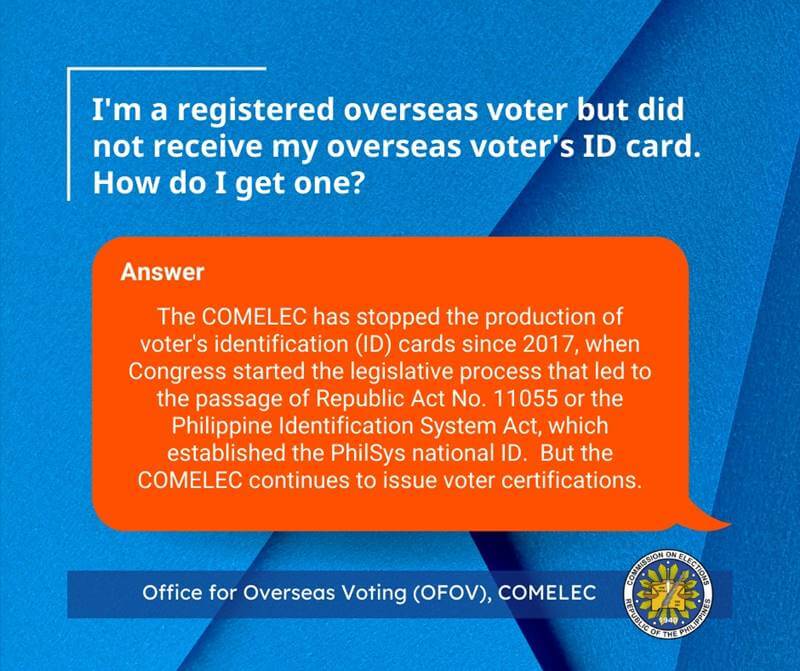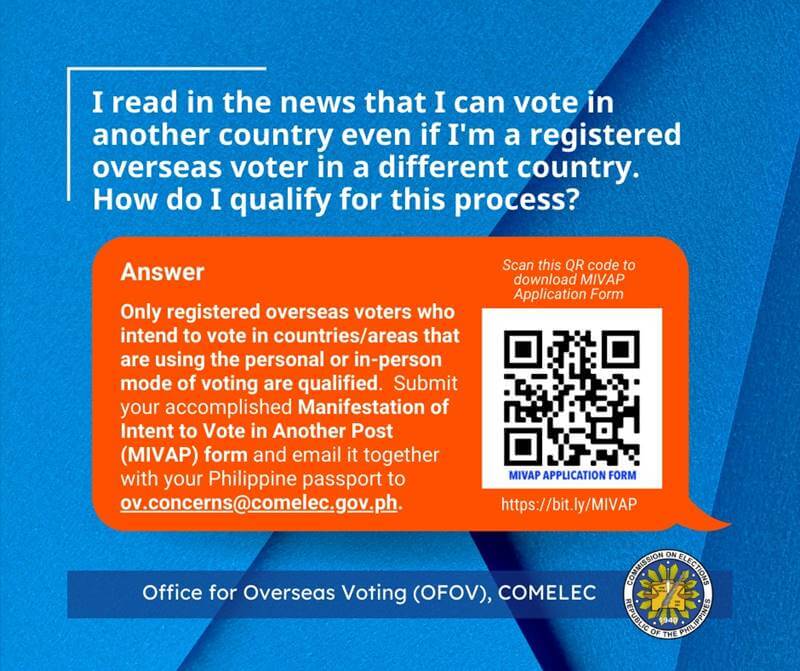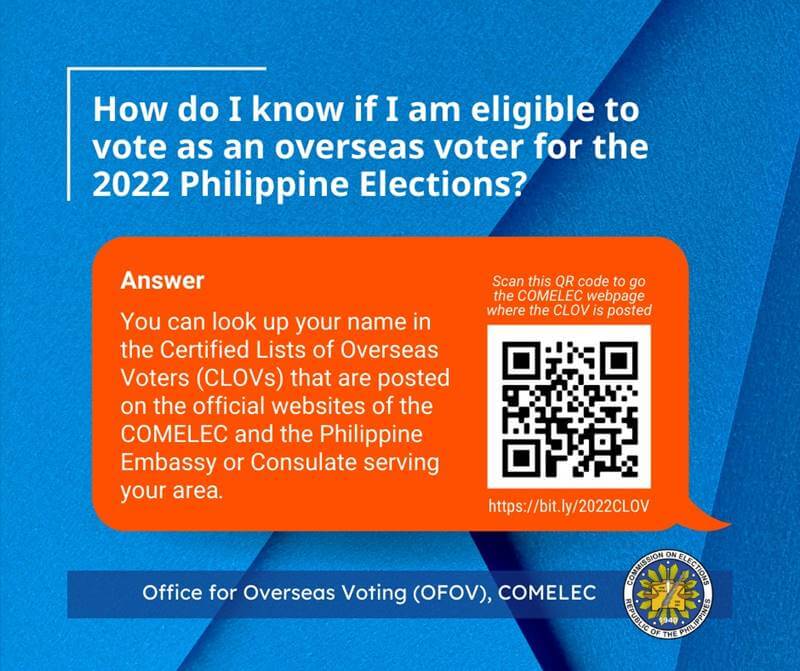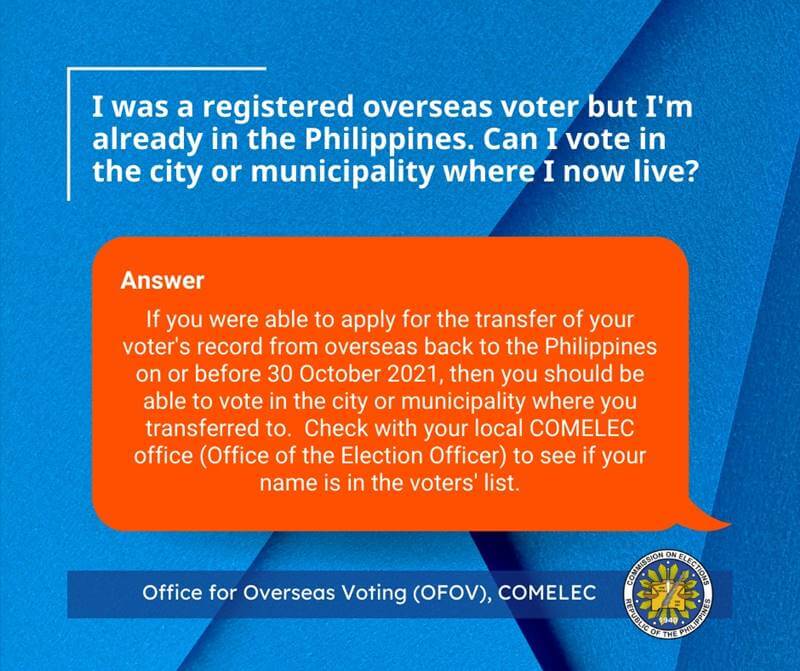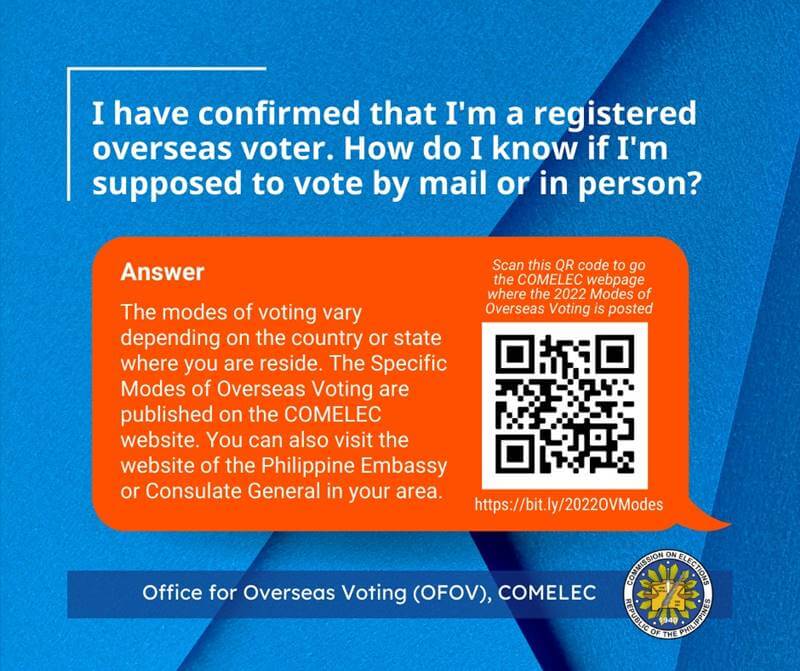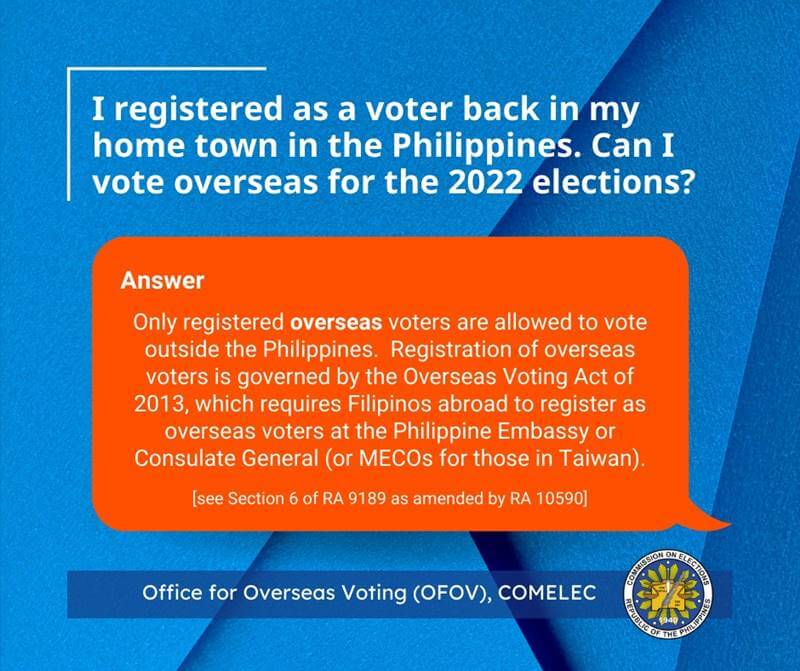Since the year is about to end, which many of us are quite excited about for good reasons – there are actually two: the holidays and the national elections in May 2022 – we do hope that you have already registered to vote for the national elections, whether you’re based in the Philippines or a Filipino working overseas.
This is important as it is an obligation as it is also your right as a Filipino citizen. And in this guide, we will be discussing some key points on what you can expect when the May 2022 elections draws closer and how to vote overseas, if this is your first time to do so.
That said, be sure to read until the end of this guide to gather all the details you ought to know about the overseas voting process.
The elections is one of the most highly controversial yet important national events for all Filipinos, whether you are based in the Philippines or overseas. The topic can actually be quite upsetting as it is engaging, especially when certain political bets and candidates are put in the spotlight.
But this post will not be about any political candidate, because our aim is to give you an idea as to what you can expect in the upcoming elections – mainly for those who will be participating from their host countries or overseas.
2022 Elections: Guide to Overseas Absentee Voting Process for Filipino Workers Abroad
![Since the year is about to end, which many of us are quite excited about for good reasons – there are actually two: the holidays and the national elections in May 2022 – we do hope that you have already registered to vote for the national elections, whether you’re based in the Philippines or overseas. This is important as it is an obligation as it is also your right as a Filipino citizen. And in this guide, we will be discussing some key points on what you can expect when the May 2022 elections draws closer and how to vote overseas, if this is your first time to do so. That said, be sure to read until the end of this guide to gather all the details you ought to know about the overseas voting process. The elections is one of the most highly controversial yet important national events for all Filipinos, whether you are based in the Philippines or overseas. The topic can actually be quite upsetting as it is engaging, especially when certain political bets and candidates are put on the spotlight. But this post will not be about any political candidate, because our aim is to give you an idea as to what you can expect in the upcoming elections – mainly for those who will be participating from their host countries or overseas. 2022 Elections: Guide In The Overseas Absentee Voting Process When you live and work in the Philippines, voting is simple, but what if you live and work elsewhere? Is it still possible for you to exercise your right to vote? You can, without a doubt, do so! If you are an overseas Filipino worker (OFW), you can vote from your host country. Filipino people living abroad who are registered voters can vote for national-level posts during national elections. The President, Vice President, Senators, and Party-List Representatives are among them. The said process is mandated by the Philippine Overseas Voting Act, and the procedure is overseen by the Office for Overseas Voting (OFOV) (R.A. 9189, amended by R.A. 10590). Who Can Register And Vote? If you meet all of the following criteria, you are eligible to register as a voter and vote in the elections, even if you are not in the Philippines. •a Filipino citizen • at least 18 years old on Election Day, and • not disqualified by law for any reason. To be able to vote overseas, you first need to register. The steps on how you can do so can be found on this post. Make sure to go through it and get back to this guide to prepare you mentally on what you will do and experience on Election Day. What Are The Requirements To Vote Overseas? Once you have registered to vote overseas, you will need to have the following documents on the date of the Election (as announced by the Philippine mission/s in your host country: • Receipt of your voter’s registration • Photocopy of Valid Passport; • Proof of Philippine Citizenship, such as a Visa, Resident Card, Notice of Action, Oath of Allegiance, etc.; and • Photocopy of Seaman’s Book (for seafarers). • A black ink pen Step-by Step Process on Overseas Voting Depending on where the OFW is stationed, overseas voting can be done in person or by mail. In any case, the voting period is usually 30 days long. In-person voting takes place at Philippine embassies, consulates, and other COMELEC-approved locations, including field voting centres and mobile voting centres. The Special Board of Election Inspectors is in charge of the voting and counting procedure (SBEI). Meanwhile, the Special Ballot Reception and Custody Group (SBRCG), which delivers ballots to registered abroad voters, handles postal voting. (Voting in Person using a vote count machine [VCM]) Step 1: Make sure your name is registered on the Certified List of Overseas Voters (CLOV), which will be posted by the Philippine mission in your area at least 120 days before the election period. After you have confirmed your record in the list of overseas absentee voters, you may proceed to prepare your documents for the Election period. Step 2: Schedule a day to vote at the Philippine foreign post (embassy or consulate), taking note of the time fame they will accommodate overseas voters into the establishment. Important: To ensure that health and safety protocols are observed, make sure to check with the website or social media pages of the Philippine foreign post you intend to visit and comply with all the safety and health requirements they will observe throughout the election period. Step 3: Similar to how voting is done in the Philippines, on-site, you will be handed a ballot, a secrecy folder, as well as a pen. After collecting these, you may then proceed to a booth and cast your vote. Step 4: Shade the ovals corresponding to the name of the candidates and party-list you want to vote for. After that, you'll hand the ballot over to the Special Board of Elections Inspectors (SBIEs) and put it into the machine. Step 5: The machine will produce a receipt after reading the ballot, which the voter will subsequently place into a designated box. (Voting in Person - Manual) Step 1: Make sure your name is on the Certified List of Overseas Voters (CLOV), which the Philippine mission in your region will post at least 120 days before the election period. You may begin preparing the documentary requirements for the Election period after you have verified your record in the certified list of overseas voters. Step 2: You must go to the Post Office or other voting locations approved by the Commission, and he/she must have a valid passport or ID. He or she will go to the Electoral Board and provide his or her name and address. Step 3: Once the voter's identification has been verified, he or she will sign and affix his or her thumbmark to the List of Abroad Voters with Voting Records (OVF No. 2-A), a certified list of overseas voters with their names and biometrics listed alphabetically, before receiving a ballot. Step 4: He or she will use a ballot secrecy folder to fill out the ballot. After voting, the voter should fold the ballot in the same manner that he or she got it and return it to the Poll Clerk, who will deposit it in the ballot box. * The poll body's SBIEs will be in charge of overseeing the voting and counting of votes. (Voting by Post) Step 1: Alternatively, if you will vote by mail, which is another way of participating in the elections abroad, expect to receive either through mail or personal delivery an envelope which contains the Official Ballot, Certified List of Candidates, Instructions to Voters, Official Ballot envelop and Paper Seals. You will need to accomplish this on your own and submit the accomplished Official Ballot through the envelope provided either through mail or personal delivery to the foreign Post. Step 2: Following completion of the ballot, the voter must place it into the "Ballot Envelope" and seal it. They must ensure that the envelope does not arrive crumpled or damaged at the embassy, consulate, or foreign facility in question. Step 3: In the section indicated in the "Ballot Envelope," the voter should write his or her entire name and sign it, then seal it with a paper seal. Step 4: They have the option of mailing it or physically delivering it to the Post Office. The ballot should be mailed as soon as possible to ensure that it arrives at the Post Office on/or before the specified time. * In addition, the Commission may permit the use of field voting centers or mobile voting centers for a limited number of days. (Voting for seafarers) For seafarers, they may vote at any Post that uses personal voting or, in the event of postal voting, at any Post with international seaports that the Department of Foreign Affairs-Overseas Voting Secretariat (DFA-OVS) has recognized and endorsed. Counting And canvassing of Overseas Votes Counting and canvassing of votes shall begin immediately after the Posts have closed. The members of the SBEIs are composed of a Chairperson, a Poll Clerk, and a Third Member. The counting of the votes will be held simultaneously with the results of the election. The chairperson will then read the names of the candidates and the office they were elected to. The poll clerk and the third member of the board will then read the results of the election. After all the votes have been counted, the chairperson will announce the total number of votes that each candidate received. The SBEI shall transmit the results of the counting to the Special Board of Canvassers (SBOC), which will then canvass the votes. Frequently Asked Questions: Overseas Voting Process 1. I was able to vote many years ago. How come my name is not in the CLOV? Your voter records will be deleted and your name erased from the CLOV if you failed to vote in the previous two (2) elections. You can seek to have your records reactivated for the 2022 National Elections until the conclusion of the registration process on September 30, 2021. 2. What should I do to check whether or not my application has been approved? If your application has been granted, you can verify it on the COMELEC (www.comelec.gov.ph) or DFA-OVS (www.dfa-oavs.gov.ph) websites on a regular basis. You can also contact your local embassy or consulate for further information. They should be able to check your record in the system and provide you with the assistance you require regarding this matter. Otherwise, they can also provide you with the information you need to deal with your situation, where possible. Coordination and timely action will be key when it comes to these things, so make sure that you are properly guided. 3. How can I check if my application has been rejected? The Resident Election Registration Board (RERB) of the FSPs or MECOs that heard your application will send you a Notice of Disapproval of your application by mail or any other means of communication. 4. I have gotten married and changed my name since I registered so my name is now different from what appears in the CLOV. Can I still vote? You may vote as long as you are one and the same person and can verify it if necessary. Please apply to alter your information once the registration process reopens so that we can update your voter records. 5. What are the options for voting for an overseas voter? An overseas voter has the option of voting in person or by mail. There are also instances when the embassy or consulate would hold mobile voting booths to accommodate as many overseas voters as possible, so make sure to get updates from the Philippine mission in your region or area. You can do so by connecting with them on social media or by visiting their official website, especially 120 days before the election period, where updates and further instructions will be issued duly for the guidance of overseas voters. 6. How long does the Overseas Voting last? The voting period is thirty (30) days long, including Philippine holidays as well as holidays of the host nations. This was specifically provisioned by the law to enable overseas Filipino workers, overseas Filipinos, as well as dual citizens, who, of course, are eligible to vote, to exercise their right to vote for the national elections. This without a doubt, will affect not only the voters but also their families, whom they might be supporting back in the Philippines and their other relatives. Thus, after you’ve registered, make time to vote in the upcoming elections! 7. When is the period for overseas voting? The overseas voting period will run from April 9 through May 9, 2022. You may get your ballot before this date and return it to us no later than April 9, 2022. Ballots received after May 9, 2022, on the other hand, will not be accepted. 8. Where does Overseas Voting take place? The voting takes place in embassies, consulates, and other Foreign Service locations that the Commission has approved to conduct the vote. Voting may also be held in field voting centers or mobile voting centers allowed by the Commission for a short period of time. As there are plenty of options to choose from, you don’t need to worry about not being accommodated to vote. Just make sure, of course, to comply with the requirements and protocols imposed by the Philippine post during this time, especially with the threat of the virus, not showing signs of letting up, anytime soon. 9. Who is in charge of the voting? The Commission deputizes a group known as the Special Board of Election Inspectors to conduct personal voting and vote counting (SBEI). The Commission deputizes a group, known as the Special Ballot Reception and Custody Group, to take custody of the ballots and deliver them to registered voters during the voting process (SBRCG). 10. Who is in charge of the vote counting? The SBEI counts ballots manually or using a vote counting machine. Through this technology, voters can rest assured that the process will not only go much smoother but also more secure, keeping the integrity of votes intact, as much as possible. 11. Who is in charge of canvassing votes? The Special Board of Canvassers is a group that the Commission deputizes to perform canvassing (SBOC). 12. In 2019, I registered as an overseas voter, but I know I'll be in the Philippines by May 9, 2022. Is it possible for me to vote in the Philippines elections in 2022? Yes, it is possible. However, you must submit a Letter-Request for Transfer of Registration Record (OVF No. 1) to your Embassy or Consulate, as well as to the COMELEC-OFOV in Manila within the prescribed period of transfer of registration. The same thing applies if you will be in another country come 09 May 2022. You must submit a Letter-Request for Transfer of Registration Record (OVF No. 1) form before your Embassy or Consulate. Final Thoughts The Philippine government has made overseas absentee voting (OAV) much more convenient and accessible for Filipinos all around the world. The thing you have to do now is to make sure that you comply with all of the requirements, check your registration status on their records, and prepare for the actual day of voting. Since the election period for overseas Filipinos will take up to a month, make sure to schedule a day in which you can either visit the embassy or fill up the ballot which can be mailed to you at your home for further convenience. Make sure to take this opportunity to think about the leaders whom you want to vote. This will determine the kind of treatment and benefits that you can get as an OFW or Overseas Filipino in the years to come not to mention the kind of government that will uphold and oversee the welfare and the rights of all Filipinos living in the Philippines. We hope that through this guide, you were able to have some idea on how you can better prepare for the upcoming elections on May 2022. When you've done your part and prepared for the elections, the next thing that you should do is to ensure that your family members do the same, and one way you can do this is by sharing this guide to other Filipinos especially those based overseas who might find value in learning how to vote overseas, especially if it is their first time. READ NEXT: List of Certified Overseas Filipino Voters Abroad](https://thepinoyofw.com/wp-content/uploads/2021/12/oav.jpg)
Filipino people living abroad who are registered voters can vote for national-level posts during national elections. The President, Vice President, Senators, and Party-List Representatives are among them. The said process is mandated by the Philippine Overseas Voting Act, and the procedure is overseen by the Office for Overseas Voting (OFOV) (R.A. 9189, amended by R.A. 10590).
Who Can Register And Vote?
If you meet all of the following criteria, you are eligible to register as a voter and vote in the elections, even if you are not in the Philippines.
- a Filipino citizen
- at least 18 years old on Election Day, and
- not disqualified by law for any reason.
To be able to vote overseas, you first need to register. The steps on how you can do so can be found on this post. Make sure to go through it and get back to this guide to prepare you mentally on what you will do and experience on Election Day.
What Are the Requirements to Vote Overseas?
Once you have registered to vote overseas, you will need to have the following documents on the date of the Election (as announced by the Philippine mission/s in your host country:
- Receipt of your voter’s registration
- Photocopy of Valid Passport;
- Proof of Philippine Citizenship, such as a Visa, Resident Card, Notice of Action, Oath of Allegiance, etc.; and
- Photocopy of Seaman’s Book (for seafarers).
- A black ink pen
Step-by Step Process on Overseas Voting
Depending on where the OFW is stationed, overseas voting can be done in person or by mail. In any case, the voting period is usually 30 days long.
In-person voting takes place at Philippine embassies, consulates, and other COMELEC-approved locations, including field voting centers and mobile voting centers.
The Special Board of Election Inspectors is in charge of the voting and counting procedure (SBEI). Meanwhile, the Special Ballot Reception and Custody Group (SBRCG), which delivers ballots to registered abroad voters, handles postal voting.
Voting in Person using a vote count machine [VCM]
Step 1: Make sure your name is registered on the Certified List of Overseas Voters (CLOV), which will be posted by the Philippine mission in your area at least 120 days before the election period. After you have confirmed your record in the list of overseas absentee voters, you may proceed to prepare your documents for the Election period.
Step 2: Schedule a day to vote at the Philippine foreign post (embassy or consulate), taking note of the time fame they will accommodate overseas voters into the establishment.
Important: To ensure that health and safety protocols are observed, make sure to check with the website or social media pages of the Philippine foreign post you intend to visit and comply with all the safety and health requirements they will observe throughout the election period.
Step 3: Similar to how voting is done in the Philippines, on-site, you will be handed a ballot, a secrecy folder, as well as a pen. After collecting these, you may then proceed to a booth and cast your vote.
Step 4: Shade the ovals corresponding to the name of the candidates and party-list you want to vote for. After that, you’ll hand the ballot over to the Special Board of Elections Inspectors (SBIEs) and put it into the machine.
Step 5: The machine will produce a receipt after reading the ballot, which the voter will subsequently place into a designated box.
Voting in Person – Manual
Step 1: Make sure your name is on the Certified List of Overseas Voters (CLOV), which the Philippine mission in your region will post at least 120 days before the election period. You may begin preparing the documentary requirements for the Election period after you have verified your record in the certified list of overseas voters.
Step 2: You must go to the Post Office or other voting locations approved by the Commission, and he/she must have a valid passport or ID. He or she will go to the Electoral Board and provide his or her name and address.
Step 3: Once the voter’s identification has been verified, he or she will sign and affix his or her thumbmark to the List of Abroad Voters with Voting Records (OVF No. 2-A), a certified list of overseas voters with their names and biometrics listed alphabetically, before receiving a ballot.
Step 4: He or she will use a ballot secrecy folder to fill out the ballot. After voting, the voter should fold the ballot in the same manner that he or she got it and return it to the Poll Clerk, who will deposit it in the ballot box.
* The poll body’s SBIEs will be in charge of overseeing the voting and counting of votes.
Voting by Post Mail
Step 1: Alternatively, if you will vote by mail, which is another way of participating in the elections abroad, expect to receive either through mail or personal delivery an envelope which contains the Official Ballot, Certified List of Candidates, Instructions to Voters, Official Ballot envelop and Paper Seals. You will need to accomplish this on your own and submit the accomplished Official Ballot through the envelope provided either through mail or personal delivery to the foreign Post.
Step 2: Following completion of the ballot, the voter must place it into the “Ballot Envelope” and seal it. They must ensure that the envelope does not arrive crumpled or damaged at the embassy, consulate, or foreign facility in question.
Step 3: In the section indicated in the “Ballot Envelope,” the voter should write his or her entire name and sign it, then seal it with a paper seal.
Step 4: They have the option of mailing it or physically delivering it to the Post Office. The ballot should be mailed as soon as possible to ensure that it arrives at the Post Office on/or before the specified time.
* In addition, the Commission may permit the use of field voting centers or mobile voting centers for a limited number of days.
Voting for Seafarers
For seafarers, they may vote at any Post that uses personal voting or, in the event of postal voting, at any Post with international seaports that the Department of Foreign Affairs-Overseas Voting Secretariat (DFA-OVS) has recognized and endorsed.
Also Read: How to Vote as a Seafarer in Philippine Elections
Overseas Voting Schedule for OFWs Abroad
The period for overseas voting for OFWs abroad has been announced and released by COMELEC. This 2022 Philippine Elections, the scheduled period to vote starts from 10 April to 9 May 2022 – 8am local time until 9 May 2022 – 7pm Philippine Time
Based on the voting period, Filipinos have 1 month to cast their vote before the actual voting takes place in the Philippines. So we should find time to visit the nearest PH Embassy/Consulate and submit our ballots.
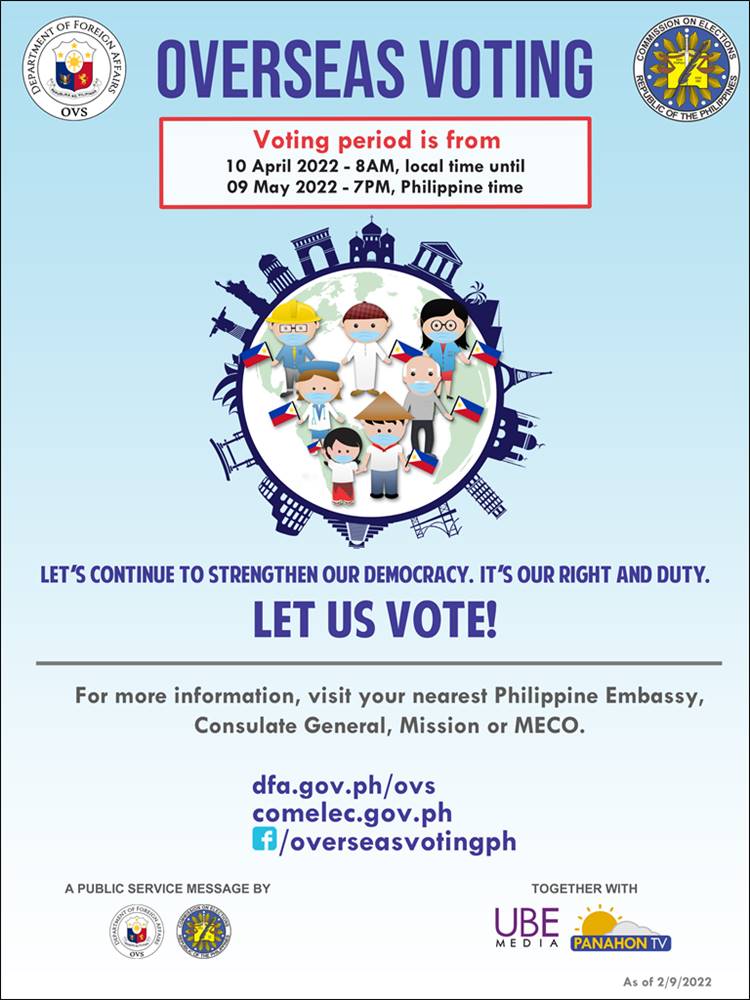
Counting and Canvassing of Overseas Votes
Counting and canvassing of votes shall begin immediately after the Posts have closed.
The members of the SBEIs are composed of a Chairperson, a Poll Clerk, and a Third Member. The counting of the votes will be held simultaneously with the results of the election.
The chairperson will then read the names of the candidates and the office they were elected to. The poll clerk and the third member of the board will then read the results of the election.
After all the votes have been counted, the chairperson will announce the total number of votes that each candidate received.
The SBEI shall transmit the results of the counting to the Special Board of Canvassers (SBOC), which will then canvass the votes.
Video: Overseas Voting Period
Check out this quick video clip as uploaded on YouTube which features the schedule for Pinoys to vote for this year’s 2022 Elections:
Frequently Asked Questions: Overseas Absentee Voting
Here are some common questions about the COMELEC overseas voting process. Please be guided accordingly:
1. I was able to vote many years ago. How come my name is not in the CLOV?
Your voter records will be deleted and your name erased from the CLOV if you failed to vote in the previous two (2) elections. You can seek to have your records reactivated for the 2022 National Elections until the conclusion of the registration process on September 30, 2021.
2. What should I do to check whether or not my application has been approved?
If your application has been granted, you can verify it on the COMELEC (www.comelec.gov.ph) or DFA-OVS (www.dfa-oavs.gov.ph) websites on a regular basis. You can also contact your local embassy or consulate for further information.
They should be able to check your record in the system and provide you with the assistance you require regarding this matter. Otherwise, they can also provide you with the information you need to deal with your situation, where possible. Coordination and timely action will be key when it comes to these things, so make sure that you are properly guided.
3. How can I check if my application has been rejected?
The Resident Election Registration Board (RERB) of the FSPs or MECOs that heard your application will send you a Notice of Disapproval of your application by mail or any other means of communication.
4. I have gotten married and changed my name since I registered so my name is now different from what appears in the CLOV. Can I still vote?
You may vote as long as you are one and the same person and can verify it if necessary. Please apply to alter your information once the registration process reopens so that we can update your voter records.
5. What are the options for voting for an overseas voter?
An overseas voter has the option of voting in person or by mail. There are also instances when the embassy or consulate would hold mobile voting booths to accommodate as many overseas voters as possible, so make sure to get updates from the Philippine mission in your region or area.
You can do so by connecting with them on social media or by visiting their official website, especially 120 days before the election period, where updates and further instructions will be issued duly for the guidance of overseas voters.
6. How long does the Overseas Voting last?
The voting period is thirty (30) days long, including Philippine holidays as well as holidays of the host nations. This was specifically provisioned by the law to enable overseas Filipino workers, overseas Filipinos, as well as dual citizens, who, of course, are eligible to vote, to exercise their right to vote for the national elections.
This without a doubt, will affect not only the voters but also their families, whom they might be supporting back in the Philippines and their other relatives. Thus, after you’ve registered, make time to vote in the upcoming elections!
7. When is the period for overseas voting?
The overseas voting period will run from April 9 through May 9, 2022. You may get your ballot before this date and return it to us no later than April 9, 2022. Ballots received after May 9, 2022, on the other hand, will not be accepted.
8. Where does Overseas Voting take place?
The voting takes place in embassies, consulates, and other Foreign Service locations that the Commission has approved to conduct the vote. Voting may also be held in field voting centers or mobile voting centers allowed by the Commission for a short period of time.
As there are plenty of options to choose from, you don’t need to worry about not being accommodated to vote. Just make sure, of course, to comply with the requirements and protocols imposed by the Philippine post during this time, especially with the threat of the virus, not showing signs of letting up, anytime soon.
9. Who is in charge of the voting?
The Commission deputizes a group known as the Special Board of Election Inspectors to conduct personal voting and vote counting (SBEI).
The Commission deputizes a group, known as the Special Ballot Reception and Custody Group, to take custody of the ballots and deliver them to registered voters during the voting process (SBRCG).
10. Who is in charge of the vote-counting?
The SBEI counts ballots manually or using a vote-counting machine. Through this technology, voters can rest assured that the process will not only go much smoother but also be more secure, keeping the integrity of votes intact, as much as possible.
11. Who is in charge of canvassing votes?
The Special Board of Canvassers is a group that the Commission deputizes to perform canvassing (SBOC).
12. In 2019, I registered as an overseas voter, but I know I’ll be in the Philippines by May 9, 2022. Is it possible for me to vote in the Philippines elections in 2022?
Yes, it is possible. However, you must submit a Letter-Request for Transfer of Registration Record (OVF No. 1) to your Embassy or Consulate, as well as to the COMELEC-OFOV in Manila within the prescribed period of transfer of registration. The same thing applies if you will be in another country come 09 May 2022.
You must submit a Letter-Request for Transfer of Registration Record (OVF No. 1) form before your Embassy or Consulate.
13. I read in the news that I can vote in another country even if I’m a registered overseas voter in a different country. How do I qualify for this process?
Only registered overseas voters who intend to vote in countries/areas that are using the personal or in-person mode of voting are qualified. Submit your accomplished Manifestation of Intent to Vote in Another Post (MIVAP) form and email it together with your Philippine passport to ov.concerns@comelec.gov.ph.
14. I’m a registered overseas voter but did not receive my overseas voter’s ID card. How do I get one?
The COMELEC has stopped the production of voter’s identification (ID) cards since 2017, when Congress started the legislative process that led to the passage of Republic Act No. 11055 or the Philippine Identification System Act, which established the PhilSys national ID. But the COMELEC continues to issue voter certifications.
15. I have confirmed that I’m a registered overseas voter. How do I know if I’m supposed to vote by mail or in person?
The modes of voting may vary depending on the country or state where you reside. The Specific Modes of Overseas Voting are published on the COMELEC website. You can also visit the website of the Philippine Embassy or Consulate General in your area.
16. I was a registered overseas voter but I’m already in the Philippines. Can I vote in the city or municipality where I now live?
If you were able to apply for the transfer of your voter’s record from overseas back to the Philippines on or before 30 October 2021, then you should be able to vote in the city or municipality where you transferred to. Check with your local COMELEC office (Office of the Election Officer) to see if your name is on the voter’s list.
17. I registered as a voter back in my home town in the Philippines. Can I vote overseas for the 2022 elections?
Only registered overseas voters are allowed to vote outside the Philippines. Registration of overseas voters is governed by the Overseas Voting Act of 2013, which requires Filipinos abroad to register as overseas voters at the Philippine Embassy or Consulate General (or MECOs for those in Taiwan).
18. How do I know if I am eligible to vote as an overseas voter for the 2022 Philippine Elections?
You can look up your name in the Certified Lists of Overseas Voters (CLOVs) that are posted on the official websites of the COMELEC and the Philippine Embassy or Consulate serving your area.
COMELEC has posted FAQs for overseas voters, please follow the guide infographic below:
Final Thoughts
The Philippine government has made overseas absentee voting (OAV) much more convenient and accessible for Filipinos all around the world. The thing you have to do now is to make sure that you comply with all of the requirements, check your registration status on their records, and prepare for the actual day of voting.
Since the election period for overseas Filipinos will take up to a month, make sure to schedule a day in which you can either visit the embassy or fill up the ballot which can be mailed to you at your home for further convenience. Make sure to take this opportunity to think about the leaders whom you want to vote for.
This will determine the kind of treatment and benefits that you can get as an OFW or Overseas Filipino in the years to come not to mention the kind of government that will uphold and oversee the welfare and the rights of all Filipinos living in the Philippines.
We hope that through this guide, you were able to have some idea of how you can better prepare for the upcoming elections on May 2022. When you’ve done your part and prepared for the elections, the next thing that you should do is to ensure that your family members do the same, and one way you can do this is by sharing this guide to other Filipinos especially those based overseas who might find value in learning how to vote overseas, especially if it is their first time.
READ NEXT: List of Certified Overseas Filipino Voters Abroad
